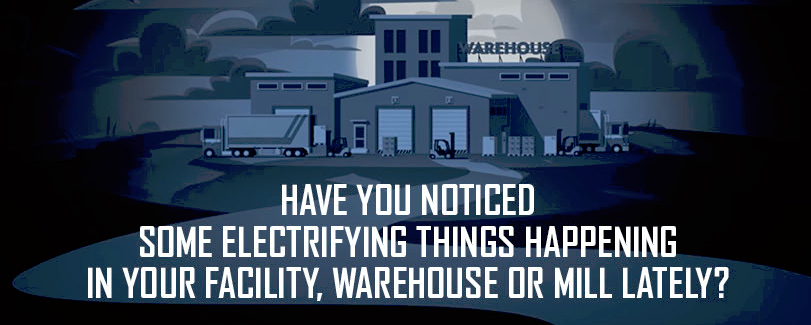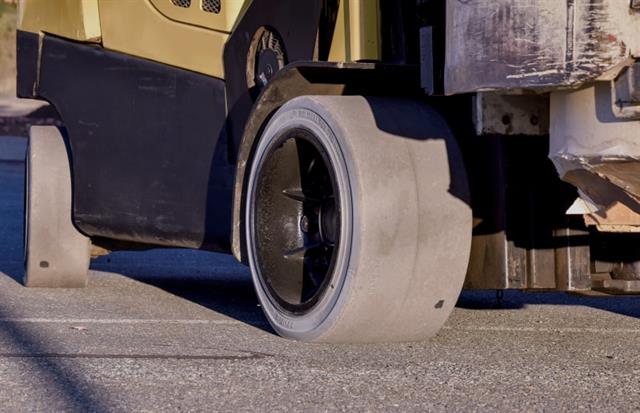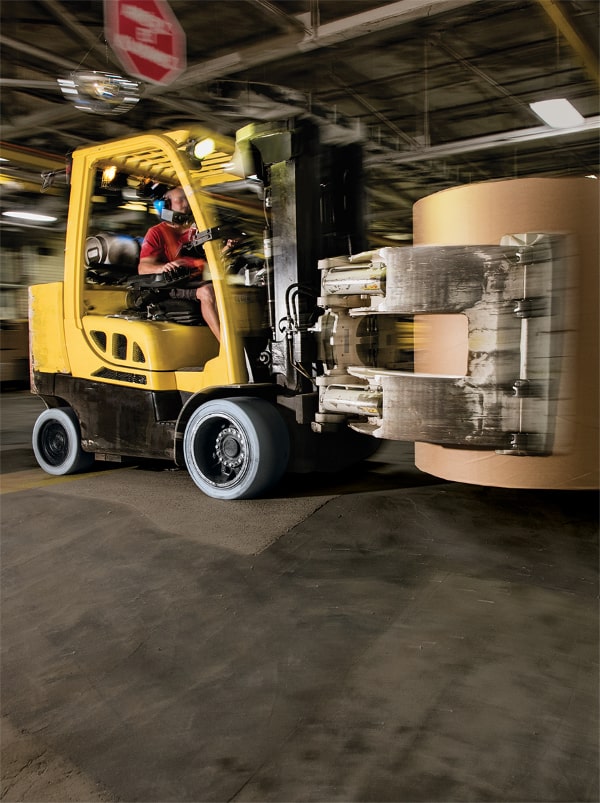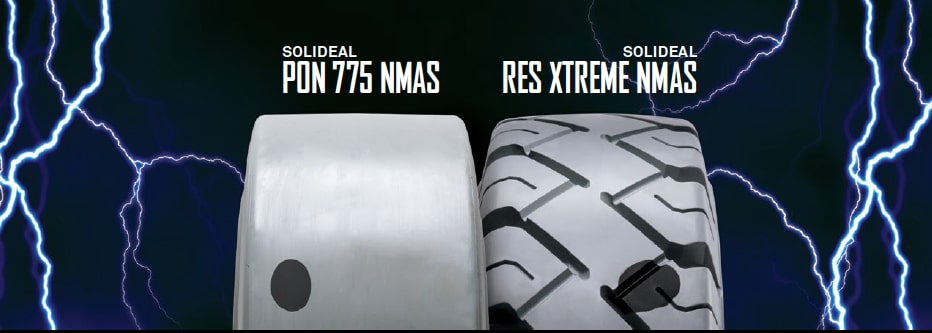Static Charges: An overlooked hazard in forklift operationsIf you ever shuffled across a carpeted floor in your socks and then fel...
![]()
Static Charges: An overlooked hazard in forklift operations
If you ever shuffled across a carpeted floor in your socks and then felt a little "zap" when you touched a metal doorknob, you've experienced the shocking effect of static buildup. Now imagine a static charge that builds up to as much as 50,000 V, and you start to appreciate the hazards that many forklift operators face every day!
How static builds up
Static electricity is generated when two dissimilar materials are rubbed together. Friction tends to displace electrons from one material to the other, creating an electrical imbalance, or static charge. Insulating materials, such as rubber, are the most prone to accumulating static until it makes contact with a more conductive material. The conductor allows the static to discharge, releasing the displaced electrons and restoring balance in the material. The release might appear as that tingle in your fingertips when you open the door, or as a massive bolt of lightning generated by turbulence in the atmosphere or, a static charge building-up in a forklift that can create major safety hazards for Material Handling operations.
The problem with non-marking tires
Forklifts using black tires generate static but they're continuously releasing their potential charge because of the carbon black used to give the rubber compound its black color. Carbon black is conductive, so it grounds the tires and gives them built-in anti-static properties.
Some applications, however, require non-marking tires: Forklifts that operate indoors, on warehouse floors with light-colored coating and surface finish or in food processing plants, for instance, are often fitted with non-marking tires.
The rubber compounds used in non-marking tires generally contain silica in place of carbon black. Where carbon black is conductive, silica is an insulator. As a result, static generated in the tires is stored rather than dissipated. The static continues to build up in the machine until it contacts another conductive material to release the charge. Unfortunately, the human body is an excellent conductor and an easy path for the electrical charge to take. Metal facility components can also provide an outlet for the static spark, including electronic controls and elevators. In either case, the results can be dangerous and costly.
The challenge of static build-up
For many years, the problem of static build-up has simply been part of the business. Non-marking tires have a role in plant hygiene and product quality; their tendency to create static is just part of the price you pay for those benefits.
Like most safety issues, the solution to hazards of static electricity must be addressed at multiple levels. The real opportunity for safety is in the hands of tire manufacturers like Camsoto respond with new tires and compounds to overcome the unique challenges of non-marking tire design.
A hazard to people and materials
![]()
During a full shift of high-speed travel and heavy loads maneuvering, forklifts can store up static charges to dangerous levels. The static charges on a forklift can be strong enough to severely injure a human being. This is why you will often see operators take pains when they dismount to ensure that they break off contact with their truck before they set foot on the floor, sometimes leaping from their seat to avoid a severe static shock. The potential for a slip & fall accident, or for disabling shock causes operator stress, ultimately leads to lack of productivity, another problem that the overall static build-up issue can cause.
Over and above the risks for injuries, facilities handling volatile fumes and chemicals have to be cautious with the forklifts. Propane-powered trucks are vulnerable to gas leaks from their own fuel tanks, as well as gas in the vicinity of a filling station. Paper and textile mills are also subject to the fire hazards of sparking the fine dust that these materials produce. In facilities that handle electronic components, static charges can wipe out circuits, data chips and firmware. Control boards and sensors that are built into the forklift itself, as well as control devices and alarms installed in the facility can even experience a major power outage.
Makeshift solutions
![]()
The industry has tried makeshift methods of dealing with problematic static. Some forklift operators will attempt to ground the vehicle by raising the forks or attachment and slamming it onto the floor. This not only damages the floor and equipment; it generally doesn't work. The frame and equipment attached to the forklift are insulated from the drivetrain components that actually accumulate the charge. Grounding the attachment does generally not ground the accumulated electricity, no matter how hard you hit it.
More commonly, users will attach chains or grounding straps under the truck. The idea is to allow the electricity to dissipate on the floor as the truck operates. But again, their effectiveness is limited. Drivetrains are still insulated from the frame by rubber mounts and bushings. Meantime, the straps and chains tend to gather dust and debris over time that gradually insulates them from the ground. They may also wear down or break off. Then more operating costs are incurred for maintenance staff to inspect and replace them.
Solving it at the source
Ultimately, the problem originates with using tires that fail to ground the vehicle and, up to recently, tire manufacturers have not offered a solution. Specialized anti-static tires are available for certain applications, but there have been no non-marking anti-static (NMAS) tires available until just the last couple years.
The development process for Camso's Material Handling team began with research into an entirely different problem in a paper mill: the customer was looking for a new press-on tire that would simply last longer. Non marking tires, while more costly than conventional black tires, typically have a much shorter lifespan than standard black solid rubber tires.
Relatively poor thermal properties also make them more prone to premature failure. By no coincidence, these relative shortcomings in heat management and wear life are both the result of removing carbon black from the rubber mix.
The Camso engineers began reworking their tire design and ran live tests with customers. The initial results were successful. New rubber compounds and performance engineering led to a non-marking tire that's 63% more thermally efficient and lasts 51% longer than our existing non-marking tires at that time. But then the customer requested "just one more thing." Could Camso also turn the new non-marking tire into an anti-static tire?
This was no simple challenge. Adding some kind of pathway for electrical conductivity in a non-marking tire was just the first step.
The engineering and product line teams field-tested different prototypes. The final design resembles other non-marking tires, but a telltale dot on the face of the tread shows where a carbon black channel had been integrated through the tire steel band. The tire provides a ground for the forklift when the black dot acts as a "plug" and makes contact with the floor on every rotation.
The breakthrough
![]()
Camsoannounced in 2018 production of the new Solideal PON 775 NMAS, which has now been available through its distribution network. Darren Stratton, Product Management Director - Material Handling claims the PON 775 NMAS is a true breakthrough in tire design: "It's not only the first non-marking anti-static tire, it will also outlast any other non-marking tire. It resists chunking and cutting, resists abrasion, and it virtually eliminates the safety hazards and downtimes of static build-up."
"We couldn't be prouder of this R&D effort," Stratton continues. "Customers who use non-marking tires on high intensity applications tend to have the most intensive material handling jobs: larger trucks, heavy loads, high speed runs, rapid maneuvering. Now they are finally getting an extreme performance tire that checks off all the boxes and provides them with the lowest operation cost solution possible for their applications."
A complete range of non-marking anti-static tires
One year after introducing our patented non-marking anti-static technology with the Solideal PON 775 NMAS, Camso introduced the Solideal RES Xtreme NMAS, a resilient non-marking tire featuring the same innovative technology and thus preventing static electricity build-up. This addition to the line-up makes us the first and only tire manufacturer to offer a complete range of non-marking anti-static forklift solid tires to answer customer's needs around the world.
![]()











 粤公网安备 44010602003952号
粤公网安备 44010602003952号